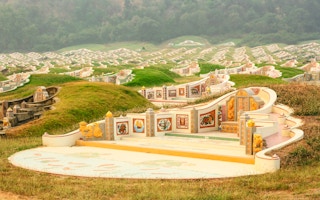In the crowded cities of Asia, the lack of space isn’t just a problem for the living: cemeteries are filling up faster than ever and governments are scrambling to solve the sensitive yet urgent problem of where to put the dead.
The simple answer has been cremation — reducing one’s remains to ashes takes up less land resources to store it compared with what is required in a traditional burial.
For this reason, it has been the de facto method actively promoted by authorities in China, Taiwan, South Korea and Hong Kong, in their bids to solve the problem of land shortage. (Japan is ahead in cremation rates due to the predominant Shinto and Buddhist burial preference of cremation over traditional burial.)
While these governments tout cremation as a form of “eco-burial”, the process itself is not as green as it may seem.
Whether it is the scattering of ashes into the ocean, a tree burial, or the storing of remains in a columbarium, what needs to happen first is the reduction of the body into ashes.
On average, a cremator has to run for 75 minutes at between 760 and 1,150 degrees Celsius to turn one dead body into complete ash. The amount of energy used is equivalent to a person’s entire month’s worth of energy needs in the home.
Besides the burning of fossil fuels, greenhouse gases are also emitted in the process, especially in the incineration of toxic materials — such as mercury in tooth fillings and resins in wooden coffins — that might be present.
The problem is compounded not only because cremation is seen as a long-term solution by many densely-populated countries, but also the sheer number of cremations that take place. In China, for example, almost half of the average 10 million burials a year involve cremation.
“
But as columbaria begin filling up and the carbon footprint of cremation continues accumulating, cremation cannot be the only solution to any one country’s grave problems.
Perhaps the authorities consider cremation the lesser of two environmental evils (compared with traditional burial, which releases methane — a greenhouse gas more lethal than carbon dioxide — and leaches toxic chemicals into the ground from embalming fluids). Cremation also makes for tangible and significant savings on land resources and allows for the convenient storage of remains.
But as columbaria begin filling up and the carbon footprint of cremation continues accumulating, cremation cannot be the only solution to a country’s grave problems. And instead of looking for ways to store the remains of loved ones, it might be more sustainable to think about returning bodies to nature in a controlled, environmentally-viable way.
Newer, arguably more sustainable methods of sending off the deceased have emerged in recent years which can present a more balanced approach to solving the problems caused by increasing populations and environmental damage caused by the cremation process.
Carbon-offsetting
Crematoria and funeral parlours can offer carbon-offsetting services (such as tree-planting) to balance out the negative environmental effects of each cremation, an option that can be further encouraged if governments offer subsidies for these services.
Promession
This is a promising alternative to cremation that eliminates greenhouse gas emissions and saves space. Still in development but already under consideration by the Swedish government, it involves freezing bodies via liquid nitrogen into a brittle state within minutes, and using vibrations to turn it into dust.
Woodland burials
Simpler methods, such as the direct burial of bodies in natural caskets or shrouds (made of plant material) take far longer, but are effective in the safe decomposition of organic material. It is already gaining popularity in the UK for being green.
These woodland burials allow us to do away with tombs and markers, and enable the conservation of large tracts of land and replace the organised graves of cemeteries with wildlife sanctuaries.
Become a tree
If cremation cannot be avoided, there is a way to turn the ashes into something that can still help the environment: put it in a biodegradable urn that contains a tree seed and nutrients required for it to flourish into a carbon-neutralising source after burial.
For those who prefer to keep the remains of their loved ones close and portable, they can place the biodegradable urn in a “tree incubator,” essentially a planter that will house the seed and eventual plant, eliminating the need for a burial ground.
Cultural obstacles
The obstacle that remains in Asia is the cultural reliance on cremation. Because ancestral worship is the cornerstone of many East Asian cultures, how the remains of the elderly are managed is a highly-sensitive, even sacrosanct, issue.
Many Chinese subscribe to the Confucian belief that in order for the soul to rest in peace, the body of the deceased has to be buried intact in a sturdy casket (hardwood or steel) for indefinite preservation, undisturbed.
The idea of leaving the body to lie in repose, exposed to soil and wildlife, is hence anathema to this concept. It also explains why many family members prefer to store cremated remains in columbaria instead of opting for sea or tree burials, where ashes are irretrievably surrendered to the elements.
Many also consider the upkeep of ancestral tombs important to their Chinese identity, using the symbolic significance of physical markers of ancestral resting places as a way to show their piety with regular care and maintenance.
Unmarked graves that do not require the need for human intervention and care are thus considered an indignity to be suffered by ancestral spirits.
But perhaps there is hope.
Cremation may run contrary to some of these beliefs, but the upsurge in cremations can be explained by the effectiveness of governmental advocacy (especially in China and South Korea). Pragmatism can also be a factor for change: prices in cemetery lots have been rising out of reach of the average wage earner, leading many to prioritise cost over beliefs.
It seems that no matter how convicted one may be to cultural or religious beliefs, it is possible for this commitment to evolve with the help of prodding from external sources such as the government.
It also proves that even millennia of cultural leanings can evolve to suit the needs of the population, as soon as its people realise that their needs and the planet’s are more aligned than ever before.


















